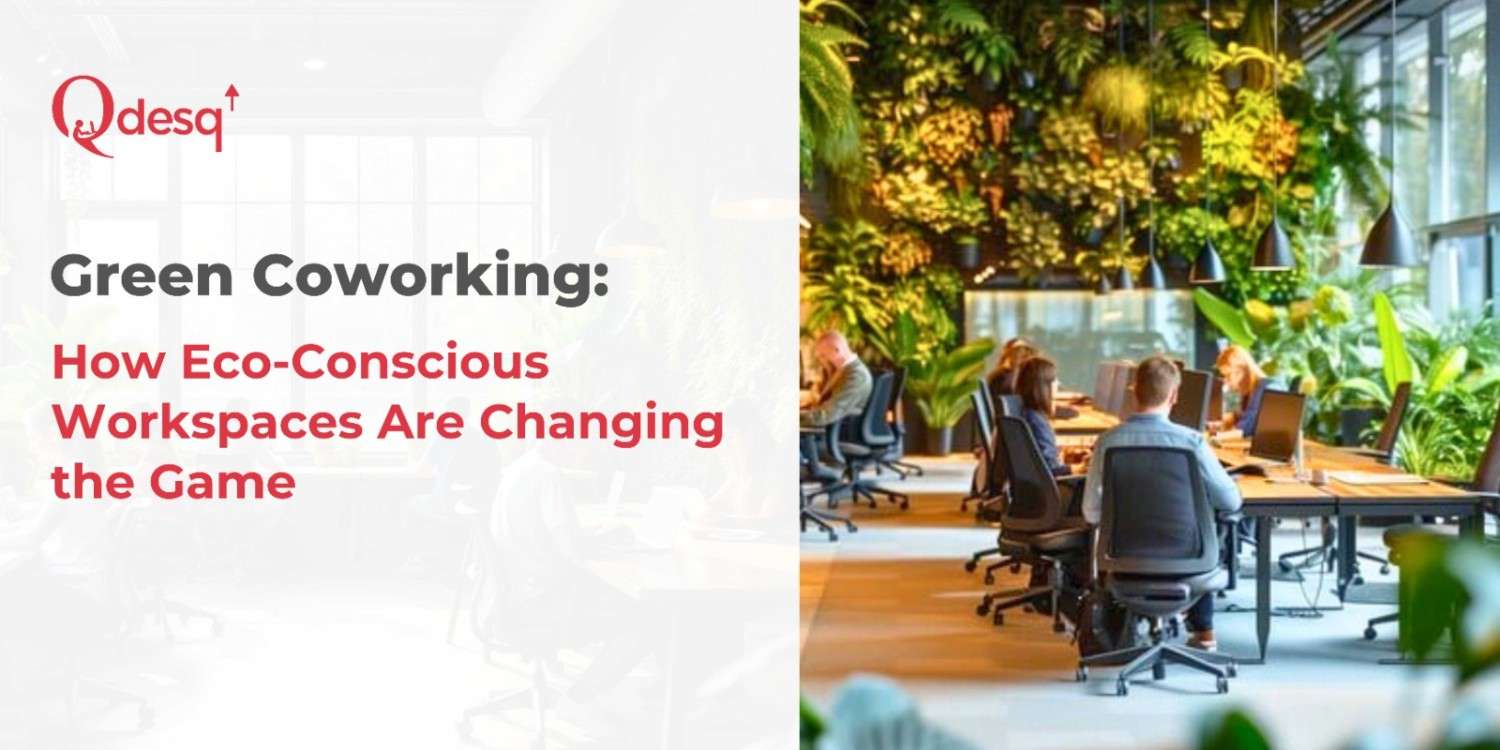In India’s race towards net-zero by 2070, green coworking spaces are emerging as trailblazers that harmonise sustainability, human-centric design, and business efficiency. By blending eco-friendly infrastructure with community-led efforts, these workspaces help startups and established businesses thrive responsibly while reducing environmental footprints.
1. Core Principles of Sustainable Design
Eco‑Friendly Materials & Build
- Use recycled or reclaimed wood, bamboo, and low‑VOC paints for healthier indoor air.
- Opt for modular, locally manufactured furniture to minimise transport emissions.
- Promote circularity by upcycling old furniture within the office.
Biophilic Integration
- Include indoor plants, living green walls, and green roofs to enhance air quality and productivity.
- Incorporate daylight through skylights and floor-to-ceiling windows, reducing dependence on artificial light.
Passive Architecture
- Arrange spaces for cross-ventilation and natural airflow.
- Use overhangs, louvres, and shade trees to block direct sun and reduce heat gain.
2. Energy & Resource Efficiency
Solar & Renewable Power
- Rooftop solar is increasingly common—spaces like Surat Diamond Bourse and Awfis Noida use panels with rainwater-cleaning robotics to boost efficiency.
- Affordable microgrid and battery storage options enable smaller centres to go off-grid during peak demand.
Smart Lighting & HVAC
- Use LED lighting, occupancy sensors, and smart thermostats to save energy.
- Shipley-style IoT systems now track energy in real time, identifying usage peaks and suggesting optimisations.
Water Savers
- Dual-flush systems, low-flow faucets, and waterless urinals can cut usage by more than 50%.
- Greywater harvesting and rainwater tanks supplement non-drinkable needs like flushing and cleaning.
3. Waste Management & Indoor Health
- Recycling & Composting Stations: Clearly labelled bins for paper, plastics, food scraps, e-waste, and general waste with simple guides to encourage participation.
- E-waste Drives & VOC-free Cleaners: Regular collection for electronics and use of non-toxic cleaning agents for healthier indoor air.
Day-to-Day Office Waste
- Employees generate ~2 kg of waste daily—mostly paper, packaging, coffee cups, and food leftovers, with ~70% recyclable.
- Plastic waste alone can add up to ~250 g per employee daily, including disposable bottles and cups.
- Around 20–30% of food is uneaten, contributing to significant food waste.
Why It Matters
- Annual waste per employee can reach ~500 kg, so robust recycling, composting, and e-waste programs are crucial.
- These systems help reduce landfill impact, create circular resource use, and engage employees in sustainable practices.
4. Sustainable Transportation & Accessibility
- Secure bike racks, showers, and changing rooms enable cycling commutes.
- Install EV charging stations and partner with ride‑share companies for discounts.
- Choose sites near metro, bus, or suburban rail to promote low-carbon commuting.
5. Tech‑Driven Resource Optimisation
- Use digital booking, billing, and check-in systems to go paperless.
- IoT energy dashboards like cloud energy management systems show real-time usage and trends.
- Some hubs deploy AI/ML algorithms to predict peak usage and adjust HVAC preemptively, saving up to 20% energy.
6. Community Engagement & Culture
- Workshops & awareness drives on composting, zero-waste commuting, and energy conservation.
- Green challenges: monthly themes like “Plastic-Free Week” or “Cycle-to-Work Month.”
- Collaborations with local NGOs, waste collectors, and eco-startups amplify impact.
- Green pledges and visible progress trackers create accountability and collective pride.
7. Tangible Benefits
- Environmental payoff: coworking footprints ~68% lower vs. traditional offices.
- Cost efficiency: energy and water reduction translate to long-term savings, which can help subsidise memberships.
- Wellness & productivity: spaces with daylight, fresh air, and nature show better focus and fewer sick days.
- Brand & leasing advantage: sustainability certifications (LEED, IGBC) position spaces as premium, appealing to environment-friendly companies and investors.
8. Challenges & Growth Strategies
High Initial Costs
- Green retrofitting demands investment, but long-term savings and incentives (e.g., IGBC rebates) soften the burden.
Behavioural Shift
- Success depends on educating users—clear signage, digital nudges, and rewards boost adoption.
Measuring Impact
- Conduct sustainability audits: monitor kWh/m², water usage, waste diverted, and CO₂ saved—and report quarterly to stakeholders.
Expanding Scale
- Modular green pods, pop‑up green coworking hubs near transit nodes or educational institutes, can accelerate urban rollout.
9. The Road Ahead: Future of Indian Green Coworking
- Development of more net-zero and energy-positive coworking hubs by 2030.
- Widespread adoption of innovative adaptive architecture, responsive to occupancy and climate.
- Integration with urban farming – rooftop farms and vertical gardens for local produce.
- Green certification standardisation for coworking (LEED for co-working) to normalise eco-design.
- Collaboration between coworking providers and municipal bodies to turn rooftops into green spaces, reduce the heat island effect, and enhance community resilience.
10. India‑Centric Case Studies: Deep-Dive
🔹 Indira Paryavaran Bhawan (Delhi)
- Certifications: GRIHA 5‑Star & IGBC (LEED) Platinum
- Energy & Water: ~40% reduction in electricity and ~55% in water use compared to standard offices
- Solar & Net-Zero: 930 kW rooftop solar array (4,600 m²) generates ~1.4 million kWh/year—fully offsetting its annual demand
- HVAC & Passive Systems: Uses chilled beam HVAC, geothermal loops (180 bores, 80 m deep) and daylighting in ~75% of spaces
- Water Management: Sewage treatment, rainwater harvesting, low‑flow fixtures; achieves zero discharge
- Green Materials & Parking: AAC fly-ash bricks, bamboo-jute interiors, soft landscaping >50% area, and robotic parking for 330 vehicles
🔹 Surat Diamond Bourse (Gujarat)
- Scale & Status: Guinness-recognised world’s largest office at 7.1 million ft², 15 floors, nine towers, interconnected atria
- Certifications & Efficiency: Pre-certified IGBC Platinum, delivers ~50% energy savings (~45 kWh/m²/yr vs. 110 kWh benchmark)
- Design Features: Radiant cooling, stack & Venturi-ventilated atria, thermal mass usage, and natural daylight reduce HVAC loads
🔹 Mindspace Madhapur (Hyderabad)
- Green Highlights: Featuring 3,500+ trees, solar rooftops, rainwater harvesting, and a LEED Gold-certified campus with lush green corridors.
🔹 One Horizon Centre (Gurgaon)
- Sustainable Design: LEED Platinum, uses energy-efficient glass, innovative HVAC systems, and water conservation features tailored by DLF.
🔹 Green Eco Coworks (Noida)
- Wellness-Focused: A hybrid coworking setup combining green design, yoga zones, and wellness facilities—ideal for eco-conscious startups.
Why These Matter:
- India’s Leading Examples: From government to corporate scale, these hubs set new standards in energy, water, materials, and healthy workplace design.
- Measurable Savings: Every case shows ≥40–50% reduction in energy and water, demonstrating real financial and environmental return.
- Scalable Design Tactics: From geothermal and chilled-beam HVAC to living facades and passive cooling—all proven at scale.
Conclusion
Green coworking in India is a powerful confluence of sustainability, wellbeing, and innovation. Urban spaces transform into healthier, more resilient hubs by embracing eco-design, renewable energy, tech-enabled efficiency, and green culture. For architects, operators, and freelancers alike, this is a call to build—and occupy—the future of workspace: one that enriches lives, safeguards the planet, and fosters purposeful growth.











